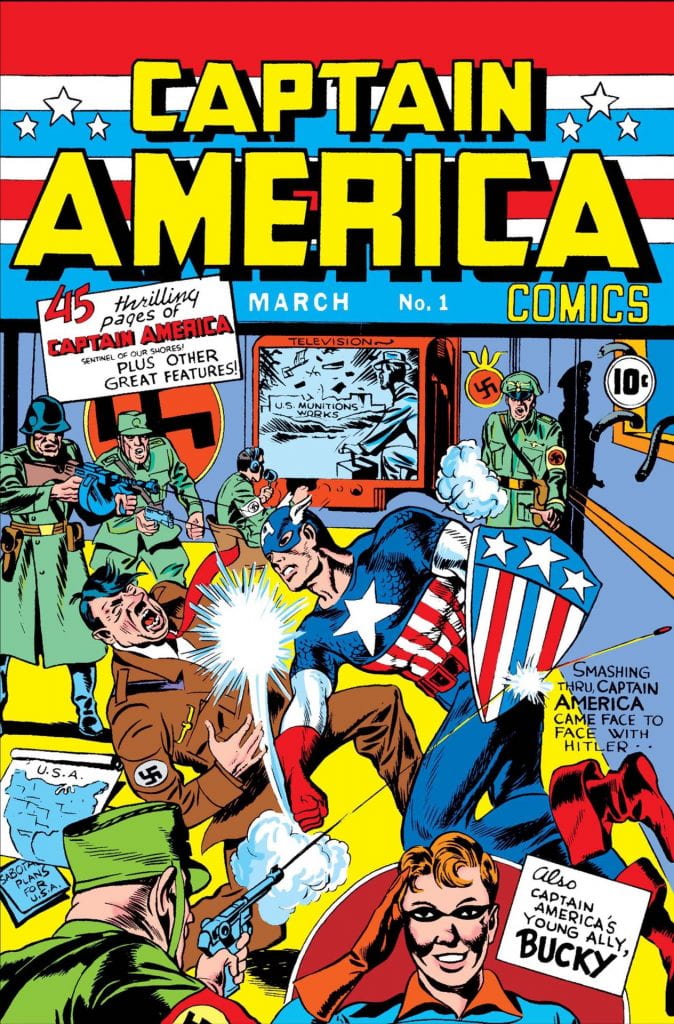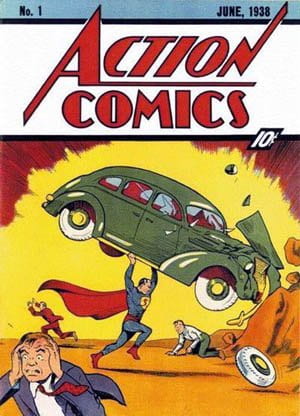“I knocked out Adolf Hitler over 200 times,” says Captain America in his title Marvel Studios film. And we laughed, because Chris Evans’ comedic timing is gold, but also because, good, knock him out again. Captain America was first published by Timely Comics, Marvel’s predecessor, in 1941, and he was a quick favorite during the wartime for obvious reasons. He fought for what was right, and every time he got knocked down, he got back up again, and that’s what the people needed during World War II. It should come as no surprise, then, that during the tail end of the Great Depression and into the long years of World War II, we have something referred to as the golden age of comics.
The golden age of comics goes from 1938, the birth of Superman, to sometime in the 1950’s, which was around the time that many superhero comics were canceled in favor of adventure, war, horror and other comic genres. The dawn of Superman in 1938 is what many consider to be the catalyst of the superhero genre’s popularity, and many superheroes even to this day are held up against Superman’s golden standard. His popularity likely has a lot to do with his historically relevant enemies. Superman can be seen defending Americans from every concern that could have plagued them, from defeating gangsters and crooked politicians in the 1930’s to selling war bonds in the 1940’s. This starts the trend for other superheroes, like Batman, Captain America, Wonder Woman, Green Lantern and Captain Marvel, all of whom get their starts and increasing popularity during this golden age.
It would make sense that these heroes were so popular during a time of economic and political strife, offering a form of hope and escape to the population that wasn’t really sure what to do or what would come next. These comics also provided some outlet for their frustrations in a time in which they had little control.
Captain America’s first published comic in 1941 depicts him punching Adolf Hitler in the face, which many received favorably, except, of course, Nazi-sympathizers, who threatened the creators. In 1940, the creators of Superman created a comic for a magazine with the title “How Superman Would End the War,” which angered the SS newsletter so much that they published an article attacking Superman. These comics were pointed and aggressive commentary that many individuals themselves did not have the agency to express on their own yet, before some of them were enlisted to fight in a war that these heroes were already fighting. Captain America Comics #1, the comic that portrays our title character socking Hitler in the face, was released nine months before the attack on Pearl Harbor.
Comics offered a cheap and portable alternative to things like radio and film, though superheroes did make their way into all sorts of media, but the comic books themselves were an accessible escape at a time that offered very little to the general population. Granted, these comics also had their own pro-America agenda, most media in wartime does, and there were some seriously racist and sexist undertones, but that doesn’t make a few of the other sentiments wrong, namely the anti-Nazi ones.
These were outlets for both the creators, some of whom were Jewish, and the readers. 44% of soldiers in basic training read comic books, and care packages often included superhero comics, according to Mike Benton, a historian on the topic. Superman’s catchphrase at the time, “truth, justice and the American way,” is quite obviously propaganda of that era, but it also fostered some unity in the common battles that were being faced, like hey, if Superman and Captain America are fighting for justice, then so am I. It likely also fostered some national unity, which I’m sure helped the war bond and enlisting efforts. But really, the major selling point here was that good always defeats evil, and I think that’s a message we’d all like to buy in this day and age too.
At the end of World War II, superhero comic sales dropped, although many of our favorites still managed to stay on the production lines, like Superman and Batman. They would fluctuate through the decades with new introductions, like the Flash, Iron Man and the X-Men, but their popularity spikes often coincide with the times in which we’re all probably wishing for a superhero.
In 2007 and 2008, America experienced the “Financial Crisis of 2007-08” (not as catchy as “The Great Recession”, but that’s just my perspective), and in 2008, like clockwork, Iron Man is released by Marvel Studios as part of what they would call “Phase 1”, but also as part of what we now know as the revival of the superhero genre. It’s quite poetic that at the time of economic disaster, Iron Man, a “genius, billionaire, playboy, philanthropist”, comes on the scene to put an end to the conflict he supplied with the money he made from it. Perhaps now, we’re just as tired of superheroes as the general population was at the end of the golden age of comics, but I wouldn’t be surprised if they made a comeback now that we’re all stuck at home with nothing but digital media streaming services. After all, these heroes tend to come up right when we need them most.
Further Reading
The Golden Age of Comic Books
https://tvtropes.org/pmwiki/pmwiki.php/UsefulNotes/TheGoldenAgeOfComicBooks
Marvel Looks Back at Iron Man—the Movie That Started It All
Superhero Comics of the Golden Age: The Illustrated History (Taylor History of Comics, Vol 4) by Mike Benton (1992)
The Powerful Popularity Of Superhero Comics During World War II
https://bleedingcool.com/comics/popularity-superhero-comics-world-war-ii/



